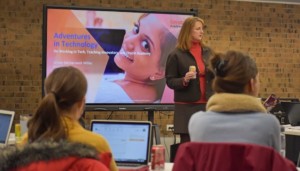Let’s Give Girls a Chance to Succeed in STEM

By: Dr. Idit Harel Caperton
There is a digital divide threatening the future of girls in this country. Three of the top ten “Best Jobs of 2013” are in the computing field, according to U.S. News and World Report, yet women make up just 25% of the labor force in science, technology, engineering and math-based (STEM) jobs. With all projections pointing to STEM-sector jobs continuing to grow at a higher-than-average rate, today’s young women cannot occupy just the fringes of the field.
With college-educated women outnumbering college-educated men, why does such inequality plague STEM-based professions? From what I hear in my work as an education technology entrepreneur, an antiquated cultural myth still exists that girls are inherently uncomfortable with computing, math and science. Research shows this myth is perpetuated by the limited number of female role models present in computing careers, and the prevalence of computing curricula that do not appeal to girls. The consequence: the national average of female enrollment in computing electives is 20-25%, despite studies showing that 74 percent of teen girls are interested in STEM.
Defeating this myth would not only provide more young women with stable professional futures, but would also improve the competitive workforce by adding skilled workers to one of the fastest growing global sectors. All this adds up to a responsibility for educators, community leaders, corporate executives, policy makers and all concerned members of society to ensure that girls have the skills and capabilities to equally seize tomorrow’s opportunities. We also must ensure every girl is exposed to innovative hands-on learning opportunities that inspire them to take advantage of these opportunities, and pursue varied future STEM possibilities.
As activists in the STEM movement, my organization answered the call for more engaging curriculum and programs by launching Globaloria in 2006 – a learning network and digital game-making platform and curriculum that teaches computational literacies and computer science skills to young learners without excluding or intimidating female students or their teachers. Globaloria introduces computing to girls in grades 6-12 by connecting programming skills to real-world problems and using hands-on creative learning activities. Integrated into the core curriculum in schools, or offered in afterschool clubs and summer camps, Globaloria contextualizes computer science into issues that already interest girls. As noted by my colleagues Lucy Sanders and Catherine Ashcraft from the National Center for Women & Information Technology (NCWIT), Globaloria propels more girls to engage in STEM learning. Their research found girls making up 37% of Globaloria classes in 2011-2012 as compared to a national average of only 25% for girls’ enrollment in computing electives.
It’s important to note that Globaloria and other similarly successful programs encourage students to create technology, not just use it. For example, at The Young Women’s Leadership School of Astoria, an all-girls’ secondary school in New York, Globaloria is integrated as a cross-curricular program in game design supporting history, social studies and foreign language learning. The first school to implement Globaloria in foreign language studies, their class, Diseñando Video Juegos (Designing Video Games), has girls learning to design and program educational games with industry-standard tools that teach Spanish vocabulary, grammar rules and other language lessons. As part of their daily learning, the girls also blog about their own work and comment on classmates’ posts in Spanish, thus driving them to call upon language learning concepts to communicate in a real-life context.
Globaloria at The Young Women’s Leadership School of Astoria is just one example of educators introducing digital learning and computing into the formal school day by asking students to collaboratively solve real-life problems through design; an approach more likely to engage girls in computer science and boost their confidence in STEM skills. Out-of-school initiatives like Girls Who Code and the national awards program Aspirations in Computing are doing impressive work recruiting and engaging girls in STEM learning, but the traditional school system needs more innovative thinking along these lines if we are going to move the needs on a national scale. New York Deputy Mayor Robert Steel made this point recently when presenting Mayor Bloomberg’s proclamation for computer science and STEM learning through coding for every New York City student at the Computer Science Education Week launch at Google.
On February 6, 2013, Digital Learning Day, we are reminded of our collective responsibility to ensure every girl has the opportunity to succeed in STEM. On this day, we call on others to support the education innovators who are creating opportunities for girls to pursue their interest in STEM learning with confidence, and to celebrate those who step up to the challenge of thinking creatively about bridging the STEM divide. The payoff will be equalizing the STEM field plus feeding the pipeline with diversity for a workforce more competitive on the global stage.
Photo Courtesy of BigStock.
Dr. Idit Harel Caperton, a Huffington Post writer, is an Israeli-American entrepreneur and founder of the non-profit World Wide Workshop.





0 Comments
Leave a Comment
Your email address will not be published. All fields are required.